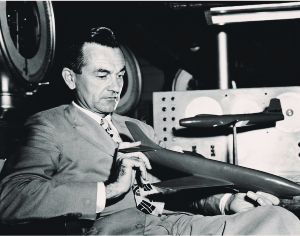 Long before any airplanes approached the sound barrier, John Stack was traveling there in his mind.
Long before any airplanes approached the sound barrier, John Stack was traveling there in his mind.
As a teenager he worked to save enough money for a few hours of flying lessons in a Canuck biplane at an airfield near his hometown of Lowell, Massachusetts. When he was accepted by MIT in 1924, he promptly enrolled in aeronautical engineering—keeping the fact a secret for the first year from his father, a successful home-builder who wanted him to study architecture. “When Dad heard about it,” he later recalled, “it was too late to protest.”
On graduating he was hired by the National Advisory Committee for Aeronautics—the forerunner of NASA—at its research center at Langley Field, Virginia, and was assigned to work on a small, experimental high-speed wind tunnel that could approach the speed of sound.
No airplanes flew anywhere near that fast, but Stack was mesmerized by both the promise of this new frontier and by its scientific strangeness. In September 1931, a highly streamlined British racing plane, the Supermarine S6.B, set a new world speed record of 401.5 miles per hour, over half the speed of sound. And as Stack quickly noted, at those speeds the air moving over the plane’s furiously whirling propeller was already in the neighborhood of Mach 1. At not much higher speeds, even the air moving over the top of the wing, as it accelerated over its curved profile, would approach supersonic speeds.
When Stack began running tests of airfoils in the new tunnel, he found some astonishing things started to happen. Both lift and drag would steadily increase with speed according to the well-understood laws of aerodynamics; then everything went haywire. The wing would suddenly stop lifting altogether and drag would shoot
up to seemingly incredible levels whenever air speeds exceeded about 80 percent of the speed of sound.
Within just a few years, in 1934, Stack was able to come up with an explanation for what was happening. The mathematical formulas of aerodynamics could only be solved by making some simplifying assumptions, foremost that air was incompressible, like water flowing around a ship. That was fine at low speeds. But as airflows accelerated, air no longer behaved like water; it did compress, getting more dense as speed and pressure mounted. Stack called this the “compressibility burble,” a strange name; but what it meant was that at these high speeds it was just not possible to brush aside the effects of compressibility and still get the right answers. He also was able to use photography to reveal why wings behaved so badly at these speeds: the supersonic flow over the top of the wing created a shock wave that caused the air to tear away from the surface of the airfoil.
Stack’s work remained mainly of interest to theoreticians—until one of the most serious crises in American aircraft development during World War II suddenly brought its practical consequences home in a hurry. Lockheed’s P-38 was the first fighter to fly faster than 400 mph; it was a beautiful and unprecedentedly powerful airplane with stainless steel skin, recessed rivets, and twin engines. It was already in production in the fall of 1941 when some alarming problems started showing up in test flights: in high speed dives the plane would shake violently, the controls would seem to lock up, and the nose would tuck under, sending the plane into an ever-steeper dive. On November 4, 1941, test pilot Ralph Virden was killed when he could not pull out of one of these dives.
All the experts consulted were baffled until John Stack diagnosed the problem: the compressibility burble was causing the wing to lose lift; that altered the angle of the air leaving its trailing edge and striking the tail, in turn generating increased lift on the tail which pitched the tail up—and the nose down.
A small flap retrofitted under the wing solved the problem. The P-38s went on to shoot down 1,800 Japanese aircraft in the Pacific Theater; Stack went on to conceive the idea of a supersonic research plane and to be awarded—with Chuck Yeager—the 1947 Collier Trophy for the world’s first faster-than-sound flight.




